| Czechoslovak Fortification 1938. |
Light Fortification.
| ||||||
|
Recommended lodging Pension a restaurace RUDOLEC Phone: (+420) 384 496 220 |
This page is dedicated to those Czechs who were forced to leave the Czechoslovak fortification bunkers with tears in their eyes after being prevented from defending their country in October 1938. |
Light forts were built to protect the main line of heavy forts against a surprise enemy attack and to stop the attack until the main line of the fortification system was ready to strike against the approaching enemy or until the mobile forces of the army reached the area. They were also built in areas where an enemy tank attack was not viable. They were constructed to stop the enemy for a few hours (Mark 36) or a few days (Mark 37).
The early types called Mark 36*)1 were only updated copies of similar objects used in different countries of the continent. They have from one to three embrasures for machine-guns. These embrasures are situated in the front of the object, so they could easily be destroyed by the fire of enemy guns. On the other hand, they have a good view towards the border, important roads or railroads and other strategic locations. These forts were not built in lines like the Mk. 37, but they were built separately or in very short lines to protect a part of an important road, for example.
There are four variations of this Mark - A, B, C and E. The types A and B have two embrasures for machine-guns Mk. 26, the type C has three embrasures and the type E has only one. The entrances to these objects are closed by steel doors. The embrasure for the machine-gun is closed by a 20 mm thick armoured cover. Type A has a 50 cm thick reinforced concrete ceiling, the wall with the embrasure for a machine-gun is 50 cm thick as well. The side of the nape is 20 cm thick. The type B and C have stronger walls - the ceiling measures 50 cm, its wall with weapons 60 cm and the side of the nape 30 cm. The crew of these forts consisted of 4-6 men.
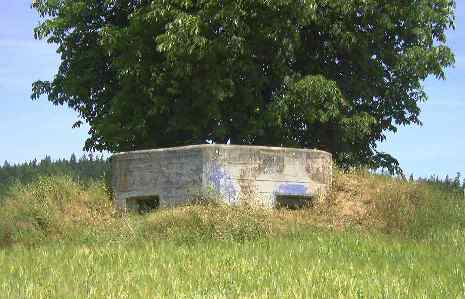 Light fort Mk. 36 A near Slavonice (2001). |
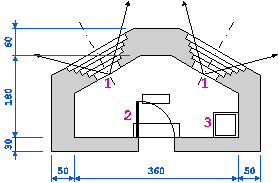 |
|
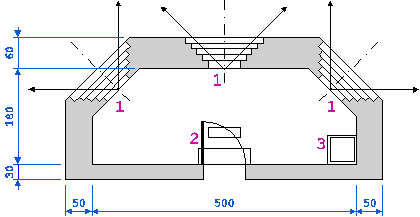 |
|
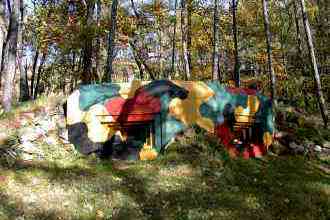 Restored fort Mk. 36 B with renewed camouflage near Drnov (2002). |
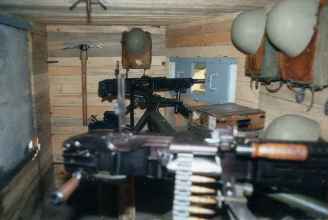 Interior of the same fort with two heavy M.G. Mark 37. |
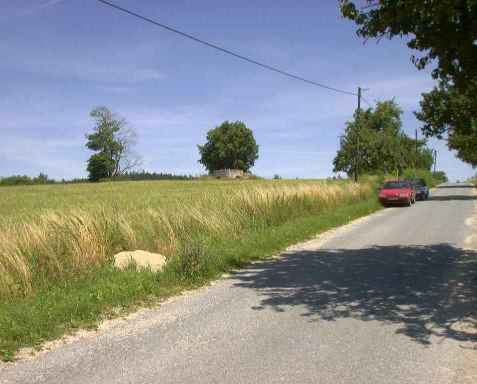 Light forts Mk. 36 were also built as a road protection. |
|
The Czechoslovak army command needed a better type of the light fort, so a new type called Mark 37 was designed which is in fact a miniature heavy fort. This type fired almost to the flank. Very few of them had an embrasure for frontal fire. Where this was the case, they were situated on a reverse slope in order to prevent the embrasure from being fired at from a long-range directly observed fire. They were in fact incapable of defending themselves from the front and their own defence depended on neighbouring posts or on fire from open positions. Their advantage in comparison to the above mentioned type was in their large number and the difficulty of hitting them. These forts were built mainly in chains (one to three or even more chains). The distance between the chains varies according to the terrain from 150 to 250 m (160 to 270 yards) and the interval between single forts from 150 to 400 m (160 to 440 yards). They were built in locations where an enemy tank attack was impossible (because of the terrain) and between the heavy forts to defend areas which could not be covered by weapons of the heavy forts. There were plans to build some for a redoubt in the interior and for the defence of Prague, but only a few of these planned forts were built. The Czechs called and still call these types ROP coll. "ropik", because ROP - Reditelstvi opevnovacich praci (Command for fortification works) co-operated on the construction of all forts.
There are also various variations of this type. The most common is the type 37 A (85% of all light forts built). This fort has two embrasures for a machine-gun designed for the flank fire to left and right. It was the biggest advantage of this type in comparison with the old Mark 36. The side towards the enemy is 80 cm thick and it is often faced with a layer of protective stones (about 1 m thick) and covered with earth. Grass was planted on top, so the fort seemed to be a small hill. This was common for all modifications of this type (except the Marks 37 C and E) and for all heavy forts. The ceiling and the wall with the embrasure is 60 cm thick. The side of the nape measures 50 cm. There were also forts built with thicker or thinner walls than these standards in some locations. These forts were equipped with periscopes (one per M.G.), a man-powered ventilator and an entrance with iron bars and armoured doors. There is one embrasure for a pistol or another personal weapon for gorge fire (entrance protection) and special tube with a cover for pushing out hand grenades to protect the undefended sides. Forts Mark 37 A are also divided by an angle between the left and right axis of the embrasure. We distinguish several types: Marks 37 A-120, -140, -160, -180, -200, -220. The crew of this fort was created by 7 men.
Another type is Mark 37 B. It has two embrasures - one for the flank and one for the direct fire. The thickness of walls is the same as at the Mark 37 A. Its equipment was almost the same, too. We also distinguish several types: Marks 37 B-80, -90, -100 (angle between axis of the embrasures) and B 1 (embrasure for the flank fire on the right side), B 2 (embrasure for flank fire on the left side). The crew of these forts sustained also from 7 men. The Mark 37 D is in fact a half of the type 37 A, because it has one embrasure for a M.G, only. These forts were built especially at the top of peaks, where the Mark 37 A could not be built. In such a case a combination of two forts was built - one 37 D1 (embrasure on the right side) and one 37 D2 (embrasure on the left side). The crew of these forts comprised 4 men.
These two types have only one embrasure designed for flanking fire (Mk. 37 E) and for protection of the undefended areas in the fort lines (Mk. 37 C). The thickness of the walls of Mark 37 C is 50 cm embrasure, 40 cm flank walls, and 20 cm side of nape; in case of Mk. 37 E 60 cm ceiling and wall with embrasure, 50 cm the flank wall and the side of the nape. The fort Mark 37 E had the same equipment as Mark 37 D, the Mark 37 C had no special equipment (periscopes, etc.). One interesting fact is that the Mark 37 C had a ceiling made of zinc only - neither concrete nor armour. The Mark 37 C had a 3 man crew and the Mark 37 E was settled by 4 men.
Only two forts were built (one G and one H) in reality. Marks 37 F, G and K were designed for one antitank gun and the Mark 37 H was in fact a place where one antitank gun used to be hidden.
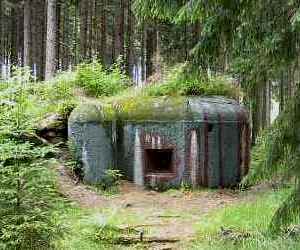 Light fort Mk. 37 A-180 near Klaster (2002). |
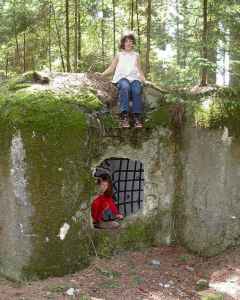 Damaged light fort Mk. 37 A-180 near Klaster (2002). |
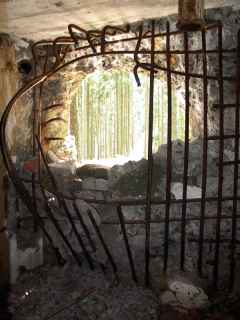 The upper right fort from inside. |
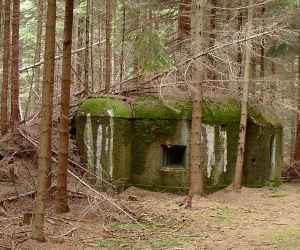 Light fort Mk. 37 A-180 near Klaster (2002). |
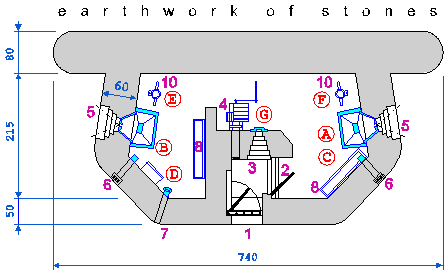 |
|
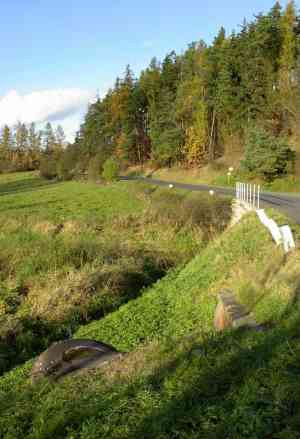 Atypical light fort Mk. 37 built in a causeway near Dolni Bezdekov (2002). |
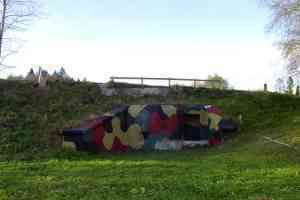 The same fort (see left) from the left-hand side. |
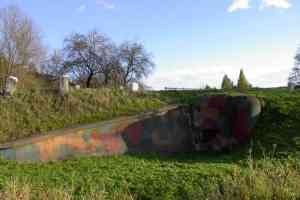 The same fort (see left) from the right-hand side. |
| weapon | calibre [mm] / [inch] |
range [m] |
rounds per minute theoretical / practical |
mass of weapon [kg] / [lb] |
cooled by | producer |
|---|---|---|---|---|---|---|
| light M.G. Mk. 26 | 7.92 / .312 | 150-2000 | 600 / 200 | 8,84 / 19.5 | air | Zbrojovka Brno |
| heavy M.G. Mk. 24 | 7.92 / .312 | 200-2000 | 560 / 300 | 24,5 / 54.0 | water | Janeckova zbrojovka Prague |
| heavy M.G. Mk. 37 | 7.92 / .312 | 300-2500 | 750 / 550 | 19,1 / 42.1 | water | Zbrojovka Brno |
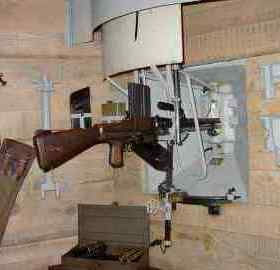 Light machine-gun Mark 26 (2002). |
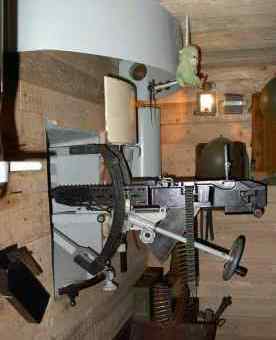 Heavy machine-gun Mark 37 (2002). |
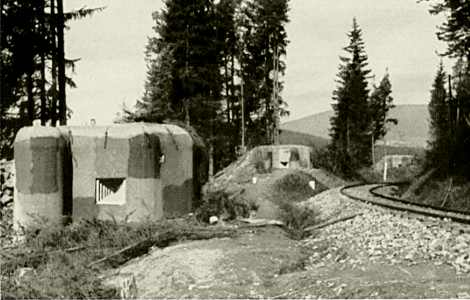 A defence line of three forts Mk. 37 along a railway. |
|
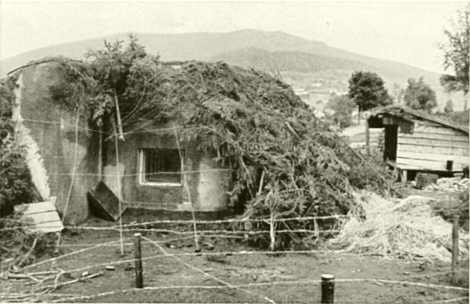 Camouflaged fort Mk. 37 (1938). | |
Remarks:
*)1
There is an established system of weapon inscription in the Czech and former Czechoslovak army since the begin of the last century. Each inscription consists of the weapon type and so called "vzor" (Mark in English) with the year in which the weapon was introduced to the army or entered its serial production.
For example:
- Lehke opevneni vzor 36 (Light Fort Mark 36; in Czech usually abbreviated as LO vz. 36) = light fort type having been introduced to the army in 1936.
- Pistole CZ vzor 75 (Pistol CZ Mark 75) = gun made by the company CZ (Ceska zbrojovka) which entered its serial production in 1975 (this very famous pistol all over the world was not used by the Czechoslovak army, because the army was forced by Russians to use Russian unified 9mm Makarov calibres).
05544 |
 |
Updated: 3rd March 2011.Music: Bedrich Smetana - My Country, Tabor. MIDI file sequenced by Petr Cvikl. |